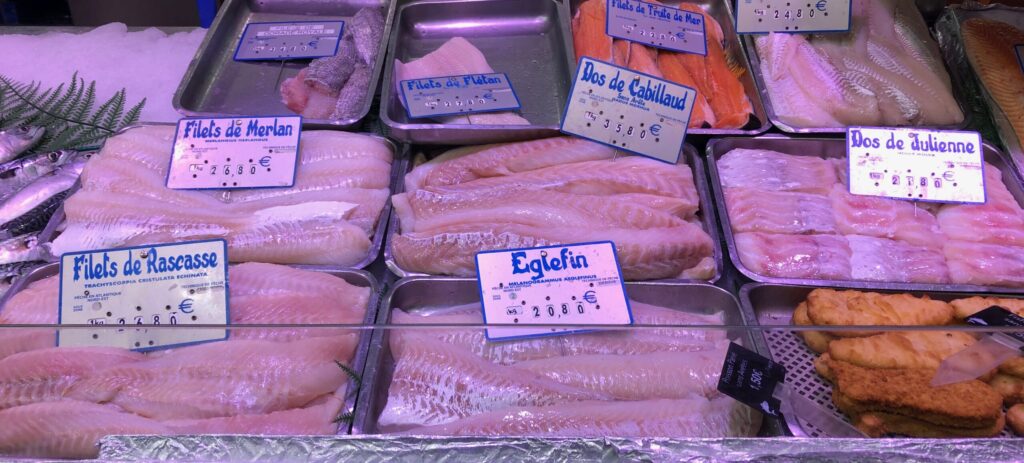
Atlantic cod (latin: Gadua morhua) is being caught in the East and West part of the North Atlantic Ocean, from East coast of Canada to the East part of the Barents Sea,from Spitzbergen in the north to Rockall and in the Baltic Sea. Atlantic cod is a groundfish, feeding close to the ocean bed on 300-400m depth. The largest stock is in the Barents Sea and Norwegian Sea followed by Iceland Grounds. These are just two stocks, but in total there are 30 independent stocks with an annual catch of around 1.1m MT.
When you buy Atlantic cod in the fresh fish counter, freezer or in a restaurant, you can be informed from which FAO area he is coming from, and some sellers give you a tracking code with information about the ICES or NAFO subarea he is coming from. But in most cases, there is very little information, and that needs to change. The normal thing should be that you know exactly which stock you are consuming.
Each fish stock needs to be managed in a sustainable way, and in most cases this is done. There is then a management plan in place, based on scientific research with an agreed total allowable catch (TAC) and quotas allocated to vessels. Many stocks are certified, e.g. by MSC, which helps the industry, in addition there is FishSource, where you can get neutral information about most stocks.
Here is a list of all known stocks of Atlantic cod and where they are harvested, with annual catch in 2019.
| Stock | Subarea | Catch area | Catch in MT |
| Northeast Atlantic FAO 27 | |||
| Northeast Arctic cod | ICES 1 & 2 | Barents Sea | 639,802 |
| Icelandic cod | ICES 5.a.1 | Iceland grounds | 265,918 |
| Norwegian coastal cod north | ICES 2.a.2 | Norway coastal >67° | 52,807 |
| North Sea, East English Channel and Skagerrak cod | ICES 3.a.20, 4.a.b.c, 7.d | North Sea, East English Channel and Skagerrak. | 31,468 |
| Faroe Plateau cod | ICES 5.b.1 | Faroe Plateau | 20,670 |
| East and Southwest Greenland cod | ICES 14.b.1, 1F | East and Southwest Grl | 18,074 |
| Eastern Baltic cod | ICES 3.2.25-32 | East Baltic Ocean | 8,283 |
| Norwegian coastal cod south | ICES 2.a.2 | Norway coastal 62-67° | 7,765 |
| Western Baltic cod | ICES | West Baltic Ocean | 7,701 |
| West of Scotland cod | ICES 6.a, 12, 14.a | West of Scotland | 1,485 |
| Celtic Sea and West English Channel cod | ICES 7.e-k | Celtic Sea and West English Channel | 1,051 |
| Irish Sea cod | ICES 7.a | Irish Sea | 302 |
| Kattegat cod | ICES 3.a.21 | Kattegat | 123 |
| Rockall cod | ICES 6.b.1 | Rockall | 66 |
| Faroe Bank cod | ICES 5.b.2 | Faroe Bank | |
| Murman cod | ICES 1.b | Barents Sea coastal | |
| Total catch in FAO area 27 | 1,075,613 | ||
| Northwest Atlantic FAO 21 | |||
| West Greenland inshore cod | NAFO 1A…F | West Greenland | 19,753 |
| Flemish cap cod | NAFO 3M | Flemish cap | 13,010 |
| Northern cod | NAFO 2J, 3KL | 10,484 | |
| South Newfoundland cod | NAFO 3Ps | South Newfoundland | 3,621 |
| West Greenland offshore cod | NAFO 1A….F | 899 | |
| North Gulf of St. Lawrence, Laurentian North cod | NAFO 3Pn, 4RS | 517 | |
| Southern Grand Bank cod | NAFO 3N, 3O | 505 | |
| South Scotian Shelf and Bay of Fundy cod | NAFO 4X, 5Y | 491 | |
| Eastern Georges Bank cod | NAFO 5Ze | 388 | |
| Eastern Scotian shelf cod | NAFO 4Vs, 4W | 81 | |
| South Gulf of St. Lawrence cod | NAFO 4T, 4Vn | 25 | |
| Labrador cod | NAFO 2GH | 0 | |
| US Gulf of Maine cod | NAFO 5Y | 0 | |
| Others not identified | NAFO 6 | 1,017 | |
| Total catch in FAO area 21 | 50.791 | ||
| Total Atlantic cod catch in 2019 | 1.130.627 |

